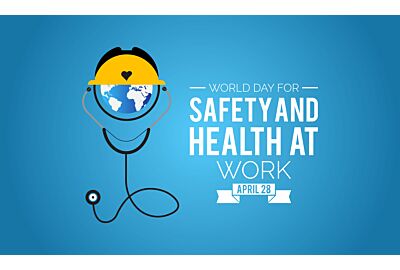On 28 April we celebrate the World Day for Health and Safety at Work.
Let’s do a bit of word association – for every topic named, what’s the first thing that comes to mind? Ready? Then let's go! Today’s theme is: Health & Safety at Work.
Well? Were Who helmets and steel-toe caps first into your mind? What about a company health plan or ergonomic office furniture? Maybe one or two still remember compensatory days taken and fun team-building activities. All these things are there to make our workplace safer on a physical and mental level. It is not the size of the measure that matters, it is often the small and inconspicuous things that make the difference. For example, a simple helmet can save a life in a freak accident, or a small bottle of sanitiser can contribute to a safe and healthy working environment.
Clean and safe at work
Yes, you read that right: sanitisers help maintain health and safety in the workplace. Because where many people come together, such as every day in an office, workshop or facility, a wide variety of viruses and bacteria also congregate. Proper hand and surface hygiene can be crucial in preventing the spread of viruses and bacteria and protecting ourselves and others. In honour of the World Day for Health and Safety at Work, we have put together a few tips for a healthy and safe working environment:
Tip 1: Don't forget to wash your hands
It sounds simple, yet it is worth mentioning again and again: proper hand washing is essential for our health. Proper washing means washing for at least 20 seconds and using an effective hand cleanser. The rest is well known to us from pandemic times: clean the palms, the tops of the hands and the spaces between the fingers equally. Obviously and practically placed soap dispensers can provide an important incentive.
Tip 2: Integrate sanitisers into the routine
As a complement to hand washing, sanitising hands is essential, especially in colder months, given the increased risk of infections and colds. Easily accessible dispensing systems can be an important motivation in this regard. Likewise, attention should be paid to the nature of the sanitiser, as no one likes to use a product that is unpleasant to use. Also, the effectiveness of a hand sanitiser is not always the same. For example, the alcohol content should be at least 70 % to ensure germs are killed. And as is often the case in life, when choosing a sanitiser, quality is important. Look for products that maintain skin condition, particularly if you use it frequently.
Tip 3: Don't forget surfaces
Cleaning and sanitising our hands is important, but it should be supplemented by the regular sanitising of surfaces. Viruses and bacteria are often deposited on surfaces that are then touched by another person. These include, for example, door handles, desk surfaces, canteen tables, lift buttons and much more. If everyone participates in regular disinfection, a certain level of basic cleaning can be created together, which ca helpn prevent the spread of viruses and bacteria. Whether you use sanitising wipes for on the go or with the help of the practical dispenser box in the office, sanitising can be quick and does not have to be a big effort.
Let's work together to ensure health and safety in the workplace. For ourselves, our colleagues and our customers!













